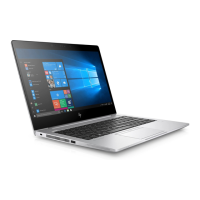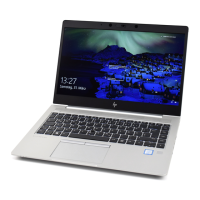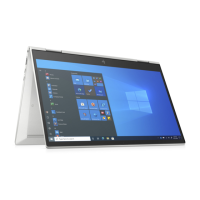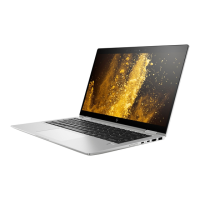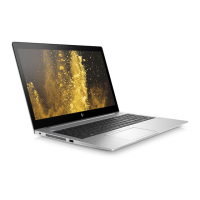Do you have a question about the HP EliteBook 745 G5 and is the answer not in the manual?
Warns about accessing self-repair parts vs. authorized service provider parts.
Instructions to prevent heat-related injuries and device overheating.
Lists AMD Ryzen processors, chipset, and graphics capabilities.
Details display panel types, resolutions, and features like touch/camera.
Covers RAM configurations and M.2 solid-state drive options.
Details Ethernet controller and wireless networking (WLAN, Bluetooth, WWAN).
Lists available ports, power requirements, and security features.
Details supported operating systems and customer-replaceable parts.
Identifies ports and indicators on the right side of the computer.
Details components located on the left side, including vents and card readers.
Identifies components around the display, such as cameras and microphones.
Details the pointing stick, TouchPad zone, and NFC tapping area.
Explains the function of various indicator lights on the keyboard.
Describes the power button, speakers, and fingerprint reader.
Identifies special keys like Esc, Fn, Windows key, and numeric keypad.
Explains the functions performed by action keys with specific icons.
Describes key combinations (Fn + key) for specific functions.
Details vents on the bottom and indicator lights on the front.
Identifies internal microphones and location of service labels.
Lists main computer components with their spare part numbers.
Details the parts that make up the display assembly.
Lists the cables included in the cable kit with their part numbers.
Lists various accessories and replacement parts like AC adapters and power cords.
Lists necessary tools and general precautions for disassembly and assembly.
Provides caution regarding the use of force when handling plastic components.
Offers advice on carefully handling and routing internal cables.
Details precautions for handling and preventing damage to storage drives.
Explains electrostatic discharge (ESD) risks and protection measures.
Provides guidelines for setting up a static-free workstation and using grounding equipment.
Step-by-step guide to removing the computer's bottom cover.
Instructions for removing and replacing the M.2 SSD.
Procedure for installing or removing memory modules.
Steps to remove and replace the wireless combo card.
Procedure for removing and replacing the wireless wide area network module.
Detailed steps for removing and reinstalling the keyboard.
Procedures for replacing the battery and heat sink assembly.
Steps for replacing USB board, RJ-45, and power button board.
Procedures for replacing speakers, fingerprint reader, and TouchPad.
Instructions for replacing NFC module and smart card reader.
Steps for replacing the fan and the system board.
Guide to replacing display assembly, hinges, cables, and covers.
Procedure for removing and replacing the top cover.
Lists subsystems validated during system startup by BIOS.
Explains how beep/blink patterns indicate major and minor error categories.
Provides examples of LED blink codes and their corresponding error conditions.
Guide to entering and navigating the BIOS setup utility.
Instructions for resetting BIOS settings to factory defaults.
Information on how to download and install BIOS updates.
Procedure to dynamically select a boot device during startup.
Details on configuring Trusted Platform Module (TPM) settings.
Information about HP Sure Start for BIOS protection and recovery.
Steps to initiate hardware diagnostic tests using UEFI.
Instructions for downloading the UEFI diagnostics tool to a USB device.
Methods for creating recovery media using HP Recovery Manager or Windows tools.
Guide to using HP Recovery media for system recovery.
Procedure to modify the boot sequence for recovery media.
Instructions for removing the recovery partition to free up disk space.
Details dimensions, weight, input power, and operating temperatures.
Lists resolution, brightness, viewing angle, and other display details.
Provides specifications for M.2 PCIe SSDs, including transfer rates and dimensions.
Details specifications for M.2 SATA SSDs, including transfer rates and dimensions.
General requirements for power cord length, capacity, and certification.
Lists country-specific requirements and accredited agencies for power cords.
Steps to restore nonvolatile memory to remove personal data.
Details the types of nonvolatile memory and their data storage.
How to reset BIOS settings and clear data.
Explanation of UEFI BIOS and its differences from legacy BIOS.
How to manage and reset Custom Secure Boot Keys.
Guidelines for proper disposal and recycling of batteries.
| Operating System | Windows 10 Pro |
|---|---|
| Processor | AMD Ryzen 7 PRO 2700U |
| Display | 14-inch, FHD (1920 x 1080) |
| RAM | Up to 32 GB DDR4 |
| Storage | Up to 1TB SSD |
| Graphics | AMD Radeon Vega Graphics |
| Weight | 1.48 kg |
| Battery | 3-cell, 50 Wh Li-ion |
| Ports | HDMI, headphone/microphone combo, docking connector |
| Wireless | Wi-Fi 5 (802.11ac), Bluetooth 4.2 |
| Dimensions | 32.6 x 23.4 x 1.79 cm |




